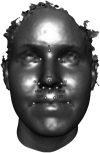Heritability of Face Shape in Twins: A Preliminary Study using 3D Stereophotogrammetry and Geometric Morphometrics
- PMID: 24501696
- PMCID: PMC3911821
- DOI: 10.5195/d3000.2013.14
Heritability of Face Shape in Twins: A Preliminary Study using 3D Stereophotogrammetry and Geometric Morphometrics
Abstract
Introduction: Previous research suggests that aspects of facial surface morphology are heritable. Traditionally, heritability studies have used a limited set of linear distances to quantify facial morphology and often employ statistical methods poorly designed to deal with biological shape. In this preliminary report, we use a combination of 3D photogrammetry and landmark-based morphometrics to explore which aspects of face shape show the strongest evidence of heritability in a sample of twins.
Methods: 3D surface images were obtained from 21 twin pairs (10 monozygotic, 11 same-sex dizygotic). Thirteen 3D landmarks were collected from each facial surface and their coordinates subjected to geometric morphometric analysis. This involved superimposing the individual landmark configurations and then subjecting the resulting shape coordinates to a principal components analysis. The resulting PC scores were then used to calculate rough narrow-sense heritability estimates.
Results: Three principal components displayed evidence of moderate to high heritability and were associated with variation in the breadth of orbital and nasal structures, upper lip height and projection, and the vertical and forward projection of the root of the nose due to variation in the position of nasion.
Conclusions: Aspects of facial shape, primarily related to variation in length and breadth of central midfacial structures, were shown to demonstrate evidence of strong heritability. An improved understanding of which facial features are under strong genetic control is an important step in the identification of specific genes that underlie normal facial variation.
Keywords: 3D stereophotogrammetry; face shape; geometric morphometrics; heritability; twins.
Figures


References
-
- Nakata M, Yu PL, Davis B, Nance WE. Genetic determinants of cranio-facial morphology: a twin study. Ann Hum Genet. 1974;37:431–43. - PubMed
-
- Nakata M, Yu PL, Nance WE. Multivariate analysis of craniofacial measurements in twin and family data. Am J Phys Anthropol. 1974;41:423–9. - PubMed
-
- Saunders SR, Popovich F, Thompson GW. A family study of craniofacial dimensions in the Burlington Growth Center sample. Am J Orthod. 1980;78:394–403. - PubMed
-
- Byard PJ, Lewis AB, Ohtsuki F, Siervogel RM, Roche AF. Sibling correlations for cranial measurements from serial radiographs. J Craniofac Genet Dev Biol. 1984;4:265–9. - PubMed
-
- Lobb WK. Craniofacial morphology and occlusal variation in monozygotic and dizygotic twins. Angle Orthodont. 1987;57:219–33. - PubMed
Grants and funding
LinkOut - more resources
Full Text Sources
Other Literature Sources
